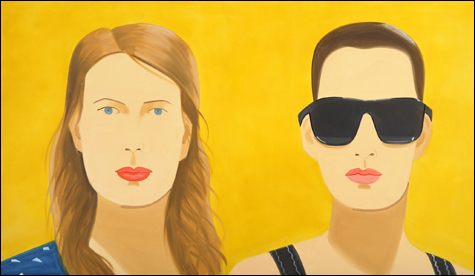
DETACHED COOLNESS “Sharon and Vivien,” 2009, by Alex Katz. |
Alex Katz is one of America's best-known modern artists. His work is so emblematic of art of our time that a graphic showing one of his paintings adorns the subscription card that drops out of my freshly-delivered art magazine every month. There's a reason for this, one that is readily apparent in his show of new and mostly large paintings at the Farnsworth Art Museum in Rockland.
Now in his early 80s and working much of the time in Lincolnville, Katz has nothing left to prove. There's a museum dedicated exclusively to his work at Colby College and his foundation has donated works by other artists to the Colby museum, helping raise that institution to a level that would be the envy of a mid-sized city.
In the 1950s, when Katz was coming of artistic age, a pressing problem was whether representation could be reconciled with the discoveries of post-war modernist abstraction. Those were powerful ideas, and no artist with a sense of seriousness could ignore them, then or now. Katz found a way to use the flatness that was part of that thinking, reducing his pictorial space to a minimum using large, even areas of color and very little modeling. He wasn't the only artist to do this, but he did it with a particular sense of style that is immediately recognizable.
That style was validated by later trends. Art audiences who were put off by the austerities of Minimalism or the ironies of Pop could still be part of the modern world — they could like a Katz painting. (Katz's images gave Andy Warhol clues to do things that helped make Warhol famous, but we can forgive Katz for that — it wasn't his fault.)
The Farnsworth show has thematic threads that exemplify the major body of Katz's work over the years. The paintings are big, often 12 feet long, so that you don't view the painting as much as stand surrounded by it. The large color areas are flat and un-modulated, fitting neatly into modernist thinking about the tension between the actual flatness of a canvas and the illusion of pictorial space.
In the 12-foot painting "Sharon and Vivien" (2009), the faces of the two women fill nearly the whole canvas, placed against a flat yellow background. One has bright blue eyes; the other wears black sunglasses that dominate her face and anchor the painting. Katz provided just enough shading to suggest the features of the heads as they stare out at the viewer. The overall effect is one of coolness with an almost Brechtian detachment, without emotional expression.
But there is more to his paintings than that. Katz has a way of making things indefinably his. In this way he resembles Sargent, depicting a social milieu through the strength of his particular artistic sensibility — no one else could have done these.
Katz shows several paintings that relate directly to Monet's late water lily paintings. In the large "Homage to Monet 8" yellow ovaloids, the floating lily leaves, are scattered across the top of the picture against a dark, almost black background. Passages of gray across the bottom suggest a lighter sky outlining the tops of trees. At the end of his life Monet spent most of his time in his garden at Giverny, painting what he saw there. After a lifetime considering color, he worked and reworked his garden paintings in way that suited only him, and in the process created a body of works that approached transcendent beauty.